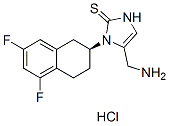All AbMole products are for research use only, cannot be used for human consumption.

Nepicastat hydrochloride (SYN117, RS-25560-197) is an inhibitor of dopamine beta-hydroxylase that catalyzes the conversion of dopamine to norepinephrine. Nepicastat hydrochloride shows the selective and concentration-dependent inhibition effects on bovine and human dopamine-beta-hydroxylase activity in vitro. In vivo, Nepicastat hydrochloride increases dopamine content and dopamine/noradrenaline ratio in a dose-dependent manner. Nepicastat hydrochloride also produces the similar effects on noradrenaline, dopamine and dopamine/noradrenaline ratio in tissues and plasma of beagle dogs. Nepicastat is currently in Phase II clinical trials in patients with Posttraumatic Stress Disorder.
| Cell Experiment | |
|---|---|
| Cell lines | |
| Preparation method | |
| Concentrations | |
| Incubation time | |
| Animal Experiment | |
|---|---|
| Animal models | spontaneously hypertensive rats (SHRs) |
| Formulation | water |
| Dosages | 3, 10, 30 or 100 mg/kg |
| Administration | p.o. |
| Molecular Weight | 331.81 |
| Formula | C14H15F2N3S.HCl |
| CAS Number | 170151-24-3 |
| Solubility (25°C) | DMSO 6 mg/mL Water 2 mg/mL |
| Storage |
Powder -20°C 3 years ; 4°C 2 years In solvent -80°C 6 months ; -20°C 1 month |
| Related Dopamine Receptor Products |
|---|
| Odapipam
Odapipam (NNC 756) is a selective, high affinity and benzazepine dopamine D1 receptor antagonist with a Kd of 0.18 nM. Odapipam is also a superior positron emission tomography (PET) radiotracer. |
| AJ-76
AJ-76 ((+)-AJ 76; (1S,2R)-AJ 76) is a dopamine autoreceptor antagonist. |
| A-412997
A-412997 is a selective Dopamine D4 agonist with Ki values of 12 and 7.9 nM for the rat and human receptors. |
| SKF 81297
SKF 81297 is a potent and selective dopamine D1 receptor agonist. |
| GBR 12783
GBR 12783 is a specific, potent and selective dopamine uptake inhibitor that inhibits the [3H]dopamine uptake by rat and mice striatal synaptosomes with IC50s of 1.8 nM and 1.2 nM, respectively. |
All AbMole products are for research use only, cannot be used for human consumption or veterinary use. We do not provide products or services to individuals. Please comply with the intended use and do not use AbMole products for any other purpose.


Products are for research use only. Not for human use. We do not sell to patients.
© Copyright 2010-2024 AbMole BioScience. All Rights Reserved.
